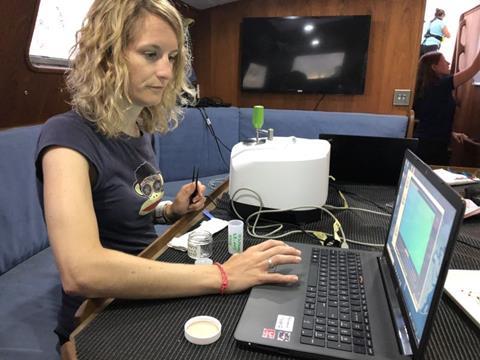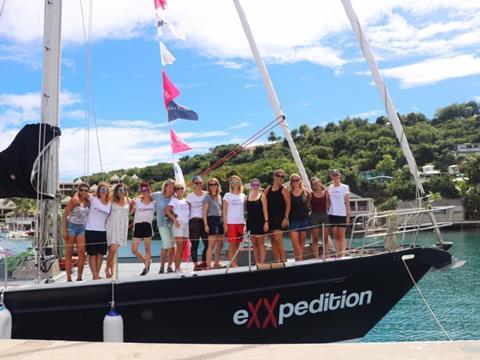eXXpedition is an all-female sailing voyage and scientific research mission with a goal to research the impact of plastic pollution in the ocean.
Marita Schmid, a sustainability expert from Mondi as well as an experienced sailor, joined a crew of 13 other women to research and highlight the impact of ocean plastics travelling from the Azores to Antigua through the North Atlantic Gyre on the on board the S.V. TravelEdge, a 73 ft expedition sailing vessel and floating research lab from 27 October to 18 November, 2019.
Mondi sponsored Schmid’s participation during the eXXpedition Round the World Leg 2 from the Azores to Antigua. Elisabeth Skoda caught up with Ms Schmid after her trip to find out more about her experiences.
What motivated you apply?

The expedition is a community interest group and not for profit. eXXpedition started in 2014, and so far has run eleven voyages. I feel really lucky to have had this opportunity. I was attracted by the sailing aspect, and the all-female aspect – and of course the foundation in science. Women are still under-represented in sailing as well as in STEM careers. The project links to several universities and contributes to a scientific base around the problem, which is important for understanding it and finding solutions. It's also about raising awareness. Working in the packaging industry, I was able to share the knowledge I gained working at Mondi and share what the industry is doing to address the challenge. I felt that I could broaden peoples’ perspectives explaining the necessity of plastics in packaging, for example when barrier properties are necessary. It was encouraging to get positive feedback.
Was the collected plastics analysed straight on the boat?
This was partly the case. The main method used every day when conditions allowed was surface sampling. Everything that was visible with the naked eye was analysed and samples were taken out and analysed straight away, to identify what kind of plastic we found. The samples that we took were also checked for micro plastics. We will receive more detailed results once everything has been analysed in the lab, but it looks like polyethylene was the plastics most frequently found.
Did you analyse mainly surface plastics or did you “dig deeper”?
We had a sub-surface depth of 25 metres, and also performed sediment sampling when we were on shore. In addition, when we saw large pieces of plastics in the middle of the ocean, such as fishing nets, we put a GPS tag on them to track their path.
Can you say what percentage of ocean plastics consisted of packaging?
It wasn’t always possible to identify that. We were able to identify the type of plastics found, such as HDPE, which is of course used a lot in packaging, but it is also used in industrial applications. But we found bottle caps and a single use spoon thousands of miles away from land in the middle of the ocean – this was heartbreaking to see.
What were your personal conclusions from the trip?
It is a wake-up call to see how much damage has already been done by humans. But on the other hand, I come from this experience with so much more energy and dedication to change the situation. I'm not sure how much can be done about the damage that's already there, but we must make sure we stop doing this right now. It is so important to bring the people together. The whole value chain has to work together – the solution lies in collaboration. There is no single solution, no single player that can really change the game.
What can the packaging industry do to address the problem?
At Mondi, we make sure that a solution is really working across the entire life cycle. We work with our customers and recyclers to make sure that what we are doing is making sense and that the packaging is fit for the product and sustainable in design. Design for recycling is a really important topic.
One of the key aspects of Mondi is that we try to be material neutral. We work out what barrier properties a product needs, how it is transported, what the shelf life should be, and find the best solution, be it paper or plastic. Each material has its advantages. Plastic as a material isn’t bad as such. If it needs to be plastics, there are ways to make it good packaging and goes through the entire life cycle without having an impact on the environment.



















